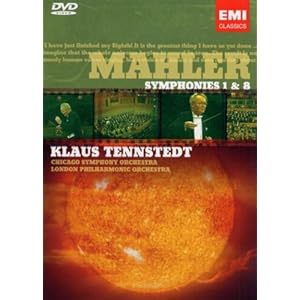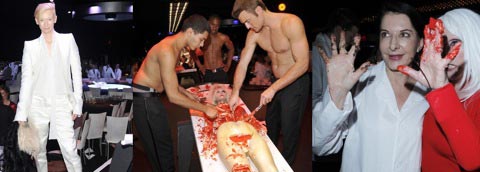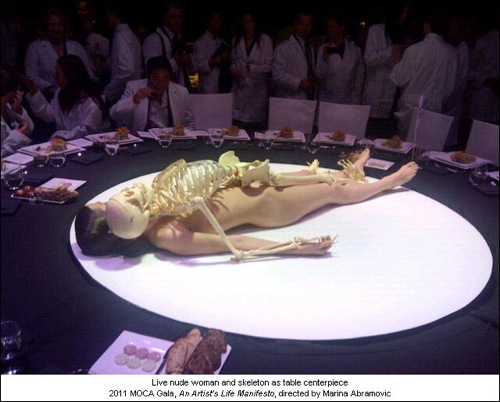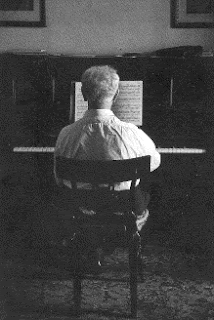Dangerous work, conducting. Read on.

Dangerous work, conducting. Read on.
I was searching youtube for a piece of cantorial liturgy when this film from a few days ago, stopped me stone dead.
Seen from behind, it looks like a traditional orthodox Jewish wedding. The groom is wearing the strictly-orthodox kittel, or shroud.
Then you notice that both grooms are wearing it. A landmark. Watch here.
I suspect that 2011 will go down as a turning point in concert etiquette. What goes on in the hall is no longer confined to those who sit in it – as we have seen several times with demonstrators and disrupters in the hall and substitutions and childbirths from the backstage. Anyone can tweet from anywhere and it’s about time concert organisations got to grips with that reality, like it or not.
A new etiquette is coming to being to replace the old, and Cincinnati is the first to recognise its relevance. As Janelle Gelfand reports here, the orchestra has set aside a corner of the hall for those who wish to communicate during a concert. Seems pretty civilised to me.
photo: AP
Our Social Correspondent reports the happy union in marriage of Maxim Vengerov,
violinist of this parish, with Olga Gringolts  , sister of the violinist Ilya Gringolts
, sister of the violinist Ilya Gringolts  .
.
The wedding was a strictly private family affair in the south of France and no photographs are being released at this moment.
We wish the young couple and their families many years of happiness.
I was fairly confident that Radio 3’s Saturday feature would miss the point of Mahler’s Eighth Symphony on record and, sure enough, I was not disappointed. The point is that a work of 1,000 performers is unlikely to be credibly conveyed through two living-room speakers or mobile headphones (let alone mobile phones). So the record industry, in its prosperous studio times, went for tame-down performances that yielded note-perfection at the expense of mass excitation. Among these performances, the programme’s choice of Claudio Abbad was among the more respectable.
But if you want the verve, the vigour and the veracity of what the symphony really sounds like when a dedicated conductor builds a performance from raw materials and lets rip on the night there are, for me, five outstanding choices – the first of which took place about a year too late for inclusion in Why Mahler?
1 Riccardo Chailly, Lepizig, May 2011 (Accentus)

2 Klaus Tennstedt (LPO Live) – a little rough, but preferable to his studio takes.
3 Tennstedt on DVD (EMI)

4 Mitropoulos in Salzburg (Orfeo)
5 Horenstein, the 1959 UK cycle premiere (BBC)
All else is compromise.
Joseph Horowitz has written a shrewd and reasoned assessment of the first Metropolitan Opera season without James Levine in the Times Literary Supplement (behind paywall). He argues that the Met used to be a conductor house, rather than a singer’s showcase, and under Luisi might become one again. Here’s his key paragraph – buy a copy to read the rest:
The Met is about glamour; Luisi is not glamorous. He defers to the orchestra when he takes his bows. He doesn’t smile at the audience. But he has won over the musicians. The best thing about the new Don Giovanni and Siegfried productions is Luisi’s way of conducting the latter, and the orchestra’s way of playing it. He is the first conuctor other than Levine to lead Siegfried at the Met since 1981. Before that, there was Erich Leinsdorf. To my ears, Luisi is a superior Wagnerian to either Levine or Leinsdorf.

As if it weren’t bad enough when Baden-Baden came poaching Simon Rattle and the Berlin Philharmonic Orchestra, Salzburg will awake on Monday to find that Aix-en-Provence is pitching for its Easter audience.
The French festival, already a serious summer contender, is opening at Easter under the joint direction of the ambitious violinist Renaud Capucon and the Marseille chamber of commerce vice-president, Dominique Bluzet. All they are announcing at the moment is 15 concerts in 10 days, no names, no content. No opera as yet, either, but the French are eager to capture a bigger slice of elite cultural tourism and Aix looks like becoming their beachhead.
Capucon, a national figure, is married to France’s most familiar news anchor, Laurence Ferrari. I guess she’ll be presenting from Aix.

Press release below:
COMMUNIQUÉ DE PRESSE
LE FESTIVAL DE PÂQUES, NOUVEL ÉVÉNEMENT MUSICAL D’ENVERGURE INTERNATIONALE À AIX-EN-PROVENCE
Aix-en-Provence a toujours affiché sa détermination de promouvoir une vie musicale riche et ambitieuse. La réputation de son festival d’art lyrique, en France et à l’étranger, et le succès du Grand Théâtre de
Provence (inauguré en juin 2007) tant auprès du public que des artistes, en sont deux preuves éclatantes.
La volonté de la ville d’aller encore plus loin, la collaboration et le talent de deux hommes : Renaud Capuçon, violoniste, et Dominique Bluzet, directeur du Grand Théâtre de Provence, l’implication constante du CIC dans cette région (CIC Lyonnaise de Banque est partenaire du festival d’art lyrique depuis 1980) conduisent aujourd’hui à la création d’une nouvelle manifestation majeure pour la musique classique : LE FESTIVAL DE PÂQUES qui positionne désormais Aix-en-Provence comme une métropole européenne incontournable de l’excellence musicale.
Sa première édition, avec une programmation prestigieuse, aura lieu du 26 mars au 7 avril 2013, durant l’année qui consacrera Marseille et sa région comme Capitale Européenne de la Culture.
UN PARTENARIAT AVEC LE CIC Aux côtés des Victoires de la Musique Classique depuis 2003, soutien de jeunes artistes, le CIC est partenaire officiel du FESTIVAL DE PÂQUES pendant 5 ans.
LA COLLABORATION ET LE TALENT DE DEUX HOMMES
Directeur artistique, Renaud Capuçon, violoniste de renommée mondiale, est une figure de premier plan de la scène musicale classique, engagé par des orchestres éminents et se produisant dans les grandes salles internationales.
Directeur exécutif, Dominique Bluzet, à la fois homme de culture et entrepreneur, dirige le Théâtre du Gymnase à Marseille, le Théâtre du Jeu de Paume et le Grand Théâtre de Provence à Aix-en-Provence. Il est également vice-président de la Chambre de Commerce et d’Industrie de Marseille.
UNE HAUTE AMBITION ARTISTIQUE
Cet événement entend se hisser à la hauteur des grands festivals européens avec près de 15 concerts sur 10 jours. Outre l’invitation aux grandes formations symphoniques internationales et aux plus talentueux so- listes reconnus ou en devenir, ce nouveau festival proposera de la musique de chambre, une carte blanche à Renaud Capuçon, le concert d’un orchestre de jeunes ainsi qu’une commande à un compositeur. Il a aussi une autre ambition : attirer, au-delà des mélomanes avertis, le plus large public.
LE LIEU DE L’EXCELLENCE MUSICALE Le Grand Théâtre de Provence, réalisé par l’architecte italien Vittorio Gregotti, unanimement reconnu comme le lieu de l’excellence musicale de la région Provence-Alpes-Côte-d’Azur, est, avec ce nouveau festival, porteur de l’un des projets musicaux les plus ambitieux en Europe.
D’une capacité de 1 382 places, doté d’infrastructures performantes dont 10 salles de répétition, il repré- sente l’un des plus gros investissements culturels hors Paris depuis 30 ans.
FESTIVAL DE PÂQUES D’AIX-EN-PROVENCE Direction artistique Renaud Capuçon Direction exécutive Dominique Bluzet Avec le soutien du CIC
Grand Théâtre de Provence
380, avenue Max Juvénal
13 100 Aix-en-Provence
CONTACTS PRESSE
FESTIVAL : Marie Lanzafame
04 42 91 69 51 / 06 15 23 45 65 marielanzafame@legrandtheatre.net
2 http://www.artsjournal.com/slippeddisc/2011/11/classical-covers-to-cry-for.html
4 http://www.artsjournal.com/slippeddisc/2011/11/very-sad-news-international-soprano-dies-at-63.html
Marina Abramovi? has been getting a lot of press in the US of late. The Serb-born performance artist makes extreme demands of herself and her dancers, mostly unclothed. The Los Angeles Times calls her ‘the most successful or recognizable performance artist working today. The New York Times in its smarmy, have-it-both-ways style, characterises her as follows:
Hardly anything Ms. Abramovic says offhand is publishable in this newspaper, any more than are photographs from the performances she has presented over the decades, during which, often naked, she has cut or burned or whipped herself, or put herself in situations the plausible outcomes of which included death.
Despite these constraints, the decadent choreographer does not want for willing performers, who are obliged to sign both a contract and a vow of silence, backed up by threats of a million-dollar lawsuit.
Which makes the following confession all the more remarkable. A dancer, Sara Wookey, keen to work with Abramovi? was offered a role ‘of one of six nude females to re-enact Abramovi?’s signature work, Nude with Skeleton (2002), at the center of tables with seats priced at up to $100,000 each.’


On reflection Sara decided that ‘what I experienced as an auditionee for this work was extremely problematic, exploitative, and potentially abusive.’
So she pulled out and wrote an Open Letter to Artists here. Read it. It is one of the strongest and most coherent I have ever encountered from a performing artist, well on its way to becoming a classic of the blog genre.
Sara Wookey performing “Trio A” at VIVA! Performance Festival in Montreal. Photo credit: Guy L’Heureux
I despair of the Cameron government, I absolutely give up on them as a creative force.
Its cultural policy is in the hands of a pearly pair known as Lazy Hunt-Vaizey  who, eager to spend longer weekends in the country, simply dump unsolved problems work on existing organisations, efficient or otherwise, and tell them to get on with it.
who, eager to spend longer weekends in the country, simply dump unsolved problems work on existing organisations, efficient or otherwise, and tell them to get on with it.
The most dispiriting part of the National Music Plan, announced today, is the decision to make Arts Council England responsible for ‘music education hubs’ around the country. These are meant to ensure that every child between 5 and 18 has access to singing or instrumental lessons.
But why the Arts Council? It’s a funding body with no track record whatsoever in education. It does accountancy, not calculus, and with a vision that ran out before Margaret Thatcher became PM.
However, its Whitehall-trained chief executive Alan Davey is very good at saying Yes Minister. He strikes Lazy Hunt-Vaizey as as safe pair of hands and, since he’s keen to save jobs among his own officials, the fix works nicely for both sides.
Lazy Hunt-Vaizey swans off to the shires and Dozy A Davey can claim a bonus that will take his pay above £200,000 next year.
For the first time since Henryk Mikolai Gorecki took the world by storm with his third symphony in 1991, a work by a contemporary composer has topped the UK classical charts.
It’s A Tender Light by Princess Kate’s wedding favourite, Paul Mealor,

and it may have benefited from Mealor’s appearance this week in Gareth Malone‘s bid to turn the army’s womenfolk into a fighting chorus. It is also top of the specialist classical chart, not the so-called classical chart which is stuffed with the likes of Katherine Jenkins.
But, small cavils aside, it’s a good record and I’m really chuffed for Mealor.
Somebody at Sony has gone down into the Columbia vaults and found all these ancient recordings that are not earning their keep. So the plan is to issue them in mega-editions that will take up so much space on your shelf there will be no room for other records. Clever, huh?
First to get the mega-treatment is Arthur Rubinstein. Sony are putting him out next month in an edition of 142 CDs, 2 videos and a glossy book for the holiday season. Biggest ever, they say. It’s the complete Rubinstein, apparently, including all the RCA and EMI sessions.

But haven’t they forgotten something? There were some Decca sessions that drove poor John Culshaw to distraction (see my history of recording for the full story). Universal must have refused to release them to a rival.
Oh, and this is not the first ‘complete’ Rubi. The last one came in 94 CDs.
And, as an alert reader quickly pointed out, the complete Bach from Hänssler comes with 172 CDs. So this is just the biggest single-artist CD box.
Here’s the press release:
Arthur Rubinstein –
The Complete Album Collection
Catalogue number 88697911362
Label Sony Classical
Price Point Budget
Format 142 CD + 2 DVD
Release date 5th December 11
Arthur Rubinstein is widely considered to be the greatest pianist of the 20th Century. He received 5 Grammy Awards between 1960-1978 for his recordings in both Chamber Music and Solo Instrumental categories and received a posthumous lifetime achievement in 1994.
Arthur Rubinstein – The Complete Album Collection is a Guinness World Record breaking product. The world’s biggest CD edition for a solo artist, it features 142 CDs and 2 Bonus DVDs from this legendary artist, all housed in a stylish cerise box with a comprehensive 164-page full colour hardback book.
142-CD plus 2-DVD limited edition